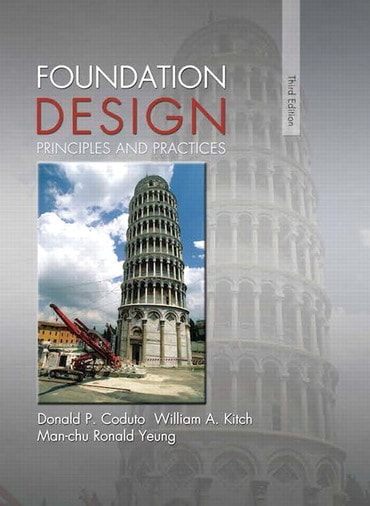
- Donald P. Coduto |
- William A. Kitch |
- Man-chu Ronald Yeung |
Title overview
For graduate and undergraduate courses in Foundation Engineering
Understanding and Practicing Foundation Design Principles
Foundation Design: Principles and Practices includes the most noteworthy research and advancements in Foundation Engineering. Following a systematic approach of identifying major concepts followed by strategic analysis and design, the Third Edition teaches students not only how to understand foundation engineering, but to apply it to real problems. The highly up-to-date material places great emphasis on limit state design and includes a new focus on load and resistance factor design in both the structural and geotechnical aspects of the process.
Foundation Design: Principles and Practices contains the following features to facilitate learning:
A multidisciplinary approach helps students gain a comprehensive view of Foundation Design
- The text integrates geotechnical, structural, and construction aspects of foundation engineering, helping students understand the importance of all three areas and how they impact each other.
- A strong presentation of basic principles and their underlying assumptions helps students develop an understanding of why foundations behave as they do.
- Frequent references to uncertainties and reliability issues help students become familiar with the sources and approximate magnitude of error in analysis and design.
- Coverage of both geotechnical and structural issues helps students complete the foundation design aspects of comprehensive design projects.
- Practical solutions to real design problems introduce students to issues they may face and provide them with the necessary tools to solve them. This helps student understand how to apply principles of analysis and design.
- End-of-chapter questions reinforce the material and test student retention of major chapter concepts, as well as their ability to complete foundation engineering problems.
Up-to-date information on the latest research and advancements in Foundation Engineering
- NEW! Emphasis on limit state design and load and resistance factor in both the structural and geotechnical aspects of foundation design and analysis reflect their broader use real in engineering practices.
- UPDATED! Allowable Stress Design methods are retained and expanded upon because of their continued widespread use.
- NEW! Chapter on uncertainty and risk foundation in engineering.
- NEW! Improved coverage of Auger Piles includes a new chapter on axial load design, reflecting major advancements in this technology.
- NEW! Design procedures place greater emphasis on the distinction between service-ability limit states and ultimate limit states.
- REVISED! Chapter on pile dynamics has been completely rewritten to include expanded information on Wave Equation Analysis and a new section on Pulse Load Testing.
- NEW! Chapters have been added to the text on important topics such as:
- Serviceability limit states in piles
- Foundation in rocks and intermediate geomaterials
- Ground improvement
Up-to-date information on the latest research and advancements in Foundation Engineering
- Emphasis on limit state design and load and resistance factor in both the structural and geotechnical aspects of foundation design and analysis reflect their broader use real in engineering practices.
- UPDATED! Allowable Stress Design methods are retained and expanded upon because of their continued widespread use.
- Chapter on uncertainty and risk foundation in engineering.
- Improved coverage of Auger Piles includes a new chapter on axial load design, reflecting major advancements in this technology.
- Design procedures place greater emphasis on the distinction between service-ability limit states and ultimate limit states.
- REVISED! Chapter on pile dynamics has been completely rewritten to include expanded information on Wave Equation Analysis and a new section on Pulse Load Testing.
- Chapters have been added to the text on important topics such as:
- Serviceability limit states in piles
- Foundation in rocks and intermediate geomaterials
- Ground improvement
The text is highly integrated with widely available software components
- Chapters throughout the text provide information assuming that students have access to necessary software.
- Once students have mastered the principles and can do the analysis by hand, software helps them do homework more quickly and easily, and permits them to explore parametric studies that would be too cumbersome to do by hand.
Table of contents
-
PART A – General Principles
-
1. Foundations
-
2. Uncertainty and Risk in Foundation Design
-
3. Soil Mechanics
-
4. Subsurface Investigation and Characterization
-
5. Performance Requirements
-
PART B – Shallow Foundation Analysis and Design
-
6. Shallow Foundations
-
7. Spread Footings—Geotechnical Ultimate Limit States
-
8. Spread Footings—Geotechnical Serviceability Limit States
-
9. Spread Footings—Geotechnical Design
-
10. Spread Footings—Structural Design
-
11. Mats
-
PART C – Deep Foundation Analysis and Design
-
12. Deep Foundation Systems and Construction Methods
-
13. Piles—Load Transfer and Limit States
-
14. Piles—Axial Load Capacity Based on Static Load Tests
-
15. Driven Piles—Axial Load Capacity Based on Static Analysis Methods
-
16. Drilled Shafts—Axial Load Capacity Based on Static Analysis Methods
-
17. Auger Piles—Axial Load Capacity Based on Static Analysis Methods
-
18. Other Pile Types—Axial Load Capacity
-
19. Deep Foundations—Axial Load Capacity Based on Dynamic Methods
-
20. Piles—Serviceability Limit States
-
21. Piles—Structural Design
-
22. Laterally Loaded Piles
-
23. Piles—The Design Process
-
24. Pile Supported and Pile Enhanced Mats
-
PART D – Special Topics
-
25. Foundations in Rocks and Intermediate Geomaterials
-
26. Ground Improvement
-
27. Foundations on Expansive Soils
-
28. Foundations on Collapsible Soils
-
Appendix A—Units and Conversion Factors
-
Appendix B—Probability Tables
-
References
-
Index